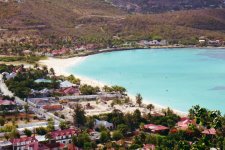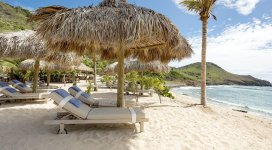Full article.
HE CESCE GIVES A NEW UNFAVORABLE OPINION ON L’ ETOILE, THE FUTURE HOTEL IN THE BAY OF SAINT-JEAN
by V.A 04/11/2020
The future Emeraude Plage is back. A modification permit has been submitted so that the project takes into account the criticisms formulated, in particular with less heavy construction on the beach side, and technical details given on the progress of the work. CESCE has consulted the new impact study for this future hotel, L’Etoile, and has given a second unfavorable opinion.
A modification permit has been filed for the future Emeraude Plage, which will be called L’Etoile, for consideration by the Executive Council. The project's impact study was once again reviewed by the Economic, Social, Cultural and Environmental Council, which published its opinion on October 1.
The document in question underlines "the advanced degradation of the ecosystem of the bay of Saint-Jean and the coral reef", and notes the need for L’Etoile to "support the restoration of the coral reefs to restore the ecosystem".
Erosion and scour
A riprap system has been added, notes the CESCE, which considers the device "very light" in relation to the risk of cyclones. While admitting that the very technical explanation is difficult for advisers to interpret; The institution therefore requests a modeling of sand movements in Saint-Jean to "better understand the risks of beach erosion". Regarding the period of excavations for the construction of the underground car park under the sand, which particularly worried the CESCE, the consulting firm also detailed the techniques that will be used. This is a process called "jet grouting," or "the high pressure injection of cement grout into vertical boreholes. There is a perimeter belt of columns 10 meters high. " The aim is to stabilize the ground during the works to avoid any risk of subsidence of the surrounding soil. “The CESCE draws the attention of the Collectivity to the risks of this technique, mainly with regard to the treatment of the enormous volume of cement grout discharges on the surface (from 5 to 50 m3 per 10m column). . This technique provides for the installation of a waste treatment and storage area (basins, tanks, etc.). "The institution stresses that" the impact study does not specify the location assigned to these facilities requiring a large space. Given the surface area of the excavated land, it goes without saying that the treatment of the tailings cannot be carried out on the project base. "
Finally, the issue of seepage water evacuation was also clarified, in these terms: "The mine water is pumped and directed to settling ponds. Once settled, this water will be sent to seepage pits on the project's base. The quality of the water before discharge and in front of the plot will be checked by a laboratory. The results will be made available to the public. Despite the details given on these technical points, the CESCE regrets the "little change" and therefore confirms its unfavorable opinion on this project. He concludes: “If the studies describe an interesting protection process, and undoubtedly effective for common hazards, the CESCE expresses all reservations about their effectiveness during future cyclones which will inevitably face the shores of Saint-Barthélemy. He encouraged the Community to request a further study with computer modeling of the effects of the sea, and suggested that it seek the advice of specialist engineers. The CESCE also draws the attention of the Collectivity to the consequences of the pumping techniques necessary for carrying out the earthworks and advises it to request additional information concerning the treatment of cement discharges and mine water, in particular their plan. implantation. "
The landscape aspect is quickly evoked: “If the amending project foresees“ only ”3 buildings of 1 floor on the beach, the fact remains that these constructions will undermine the coherence of the natural and urban landscape of The area. "
Attacked by St Barth
Essential and Eden Rock
The building permit for the future Etoile hotel has been the subject of several appeals before the administrative court. Two summary suspension (emergency proceedings aimed at stopping the site due to irregularities), filed by the Saint-Barth Essentiel association and by the neighboring hotel, Eden Rock, were challenged by the administrative court. The validity of the building permit is now being examined on the merits by the courts, again, on two requests from Eden Rock and Saint-Barth Essentiel. A petition calling for the downward revision of the project had obtained 2,700 signatures.






